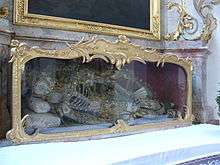Catacomb saints

Catacomb saints are ancient Roman corpses that were exhumed from the catacombs of Rome, given fictitious names and sent abroad as relics of saints from the 16th century to the 19th century.[1] They were typically lavishly decorated with gold and precious stones.[2]
History
During the Beeldenstorm of the 16th century and continued iconoclasm of the 17th century, Catholic churches throughout Europe were systematically stripped of their religious symbols, iconography and relics. In response, the Vatican ordered that thousands of skeletons be exhumed from the catacombs beneath the city and installed in towns throughout Germany, Austria and Switzerland.[3]
Few, if any, of the corpses belonged to people of any religious significance though, given their burial, some may have been early Christian martyrs.[4] Each was nonetheless painstakingly dressed and decorated as one of the various Catholic saints.[3] One church spent 75 gulden dressing their saint.[4]
Though selling the relics would have been considered simony, enterprising church officials still managed to raise funds while countering the iconoclasm by charging for transportation, decoration, induction and blessing.[2] Historian and author Diarmaid MacCulloch compared the collection of catacomb saints by rich Bavarian families as being akin to the modern-day practice of purchasing personalised number plates, given that many of the saints shared the name of their patron.[5] Church officials became adept at uncovering saints related to particular wealthy families.
By the 19th century, many of the fakes had been discovered. Some were stripped of their finery and destroyed while others were placed in storage.[3]
Modern interest
In 1803, the secular magistrate of Rottenbuch in Bavaria auctioned the town's two saints. 174 years later, in 1977, the residents of the town raised funds to have them returned.[2]
Paul Koudounaris revived interest in the catacomb saints with his 2013 book Heavenly Bodies. In publishing the book, Koudounaris sought to find and photograph each of the extant saints.[2][3]
Gallery
 The decorated skull of "Saint Dominicus".
The decorated skull of "Saint Dominicus".- The armed corpse of "Saint Verena".
- A glass case protects the corpse of the "martyr Candidus" at the Irsee Abbey, Bavaria.
 The sarcophagus of "Saint Clemens" at the Parish church of St. Gallus and Ulrich, Kißlegg, Germany
The sarcophagus of "Saint Clemens" at the Parish church of St. Gallus and Ulrich, Kißlegg, Germany
References
- ↑ Johnson, T. (2009). "Holy Fabrications: The Catacomb Saints and the Counter-Reformation in Bavaria". The Journal of Ecclesiastical History. 47 (2): 274. doi:10.1017/S0022046900012872.
- 1 2 3 4 Christopher Howse (22 August 2013). "The ghastly glory of Europe’s jewel-encrusted relics". The Telegraph.
- 1 2 3 4 Blake, Matt (6 September 2013). "Incredible skeletal remains of Catholic saints still dripping in gems and jewellery discovered by 'Indiana Bones' explorer". Daily Mail. Retrieved 8 September 2013.
- 1 2 Johnson, Trevor (2009). Magistrates, Madonnas and Miracles: The Counter Reformation in the Upper Palatinate. Ashgate Publishing. ISBN 9780754664802.
- ↑ Macculloch, Diarmaid (2004). Reformation: Europe's House Divided 1490-1700. Penguin UK. ISBN 9780141926605.
Further reading
- Koudounaris, Paul (2013). Heavenly Bodies: Cult Treasures & Spectacular Saints from the Catacombs. London: Thames & Hudson. ISBN 9780500251959.
| Wikimedia Commons has media related to Catacomb saints. |